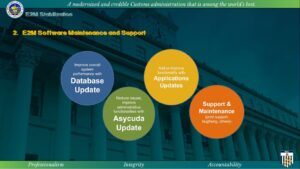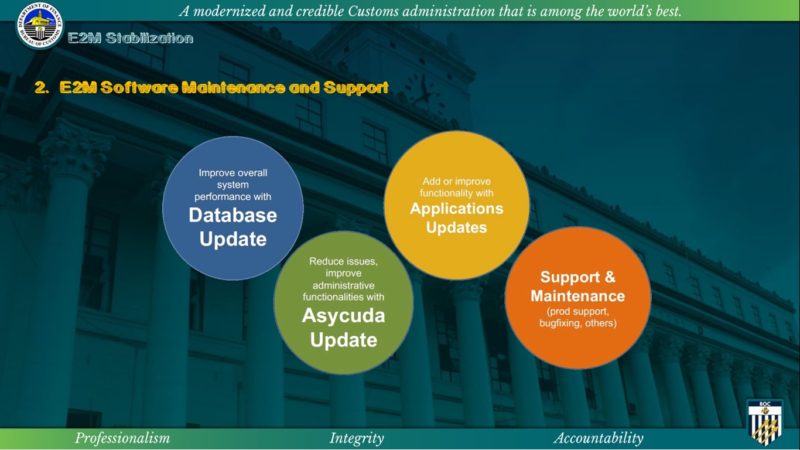
While awaiting a new customs system, the Bureau of Customs (BOC) is implementing projects to stabilize and enhance the performance of its erratic Electronic-to-Mobile (E2M) System, and these efforts have borne results, according to the agency.
“The new customs system is still years away until implemented so we implemented projects to stabilize the current system until we acquire a new customs system,” Management Information System and Technology Group (MISTG)-Technical Management Service officer-in-charge Jonathan Soriano said in a recent BOC webinar.
Heeding the suggestion of the Word Bank (WB) in 2017, the customs bureau has undertaken a program to stabilize the E2M, the system which was implemented in 2005 on top of BOC’s Automated System for Customs Data (Asycuda++), which in turn was installed 10 years earlier, in 1995.
The E2M now needs to be replaced because it has an outdated infrastructure, a weak information security module, and an archaic risk management system.
Soriano noted that prior to the stabilization projects, the E2M system since 2013 has not been maintained, supported or upgraded by the contractor as it should have done. It is MISTG that has maintained the system despite lacking the capacity to address bugs and fix issues.
Soriano also said previous attempts by BOC to procure an upgraded or new system had failed.
“To compensate for the failed procurement of a new system, a maintenance and support project was acquired to keep the current E2M System operating until a new customs system is implemented,” Soriano added.
READ: BOC e2m capacity expansion set for the first quarter
Former MISTG deputy commissioner Jeffrey Ian Dy earlier said the stabilization project will enable E2M—which is incapable of parallel computing—to “survive in the next two, three years.” These projects will address issues behind the slowdown of E2M through the conduct of archiving and redesigning of databases for backup purposes. Dy noted that E2M’s database has gotten so large that archiving is crucial to make the system operate faster.
Soriano said BOC has already acquired and implemented hardware and software systems as part of the stabilization project.
Acquired hardware includes several servers, some of which, like the high-performance server and co-location servers, were implemented last year, while the disaster recovery server is now being deployed.
For software, BOC in June 2019 awarded its two-year E2M maintenance project, which includes data archiving and replacement of the Asycuda++ system.
BOC also awarded in August 2020 its Backup Network project, which provides network redundancy that can take over when the primary network goes down.
Soriano said that to improve the agency’s information and communications technology (ICT) infrastructure, BOC has also made use of a private cloud environment to “provide an easily manageable, flexible and reliable high-capacity environment to host BOC systems and database.”
Soriano said that with these enhancements, BOC has been able to implement several modules in the E2M System such as the Universal Risk Management System and Enhanced Value Verification System, which were enforced in May and August 2020, respectively.
He added that the “E2M maintenance and support can now address all issues and enhancement needed to keep the customs system running.”
“The effects of these upgrades resulted in noticeable E2M performance and reliability. Currently, the E2M system has experienced no slowdown or downtime since the upgrade were done,” Soriano claimed.
He acknowledged, however, that it remains to be “a continuous process and we will continue to implement enhancements to ensure that our stakeholders get the best service needed.”
For the long term, BOC looks forward to the implementation of the Philippines Customs Modernization Project, which was proposed by WB in 2017. The project will modernize customs operations to improve BOC’s core customs processing system, related technical infrastructure, and internal capacity in order to implement a sophisticated ICT that will enhance BOC’s operations, integrity, accountability, and organizational performance.
READ: BOC’s P5.5B modernization program closer to reality
The National Economic and Development Authority (NEDA) Board gave an “ad referendum approval” on May 27, 2020 for the proposed P5.5 billion modernization program of BOC.
The project, which seeks to improve Customs efficiency and reduce trade costs, was one of the options considered for the automation plan of the bureau. The project was approved March 6, 2020 by the NEDA Investment Coordination Committee Cabinet Committee. – Roumina Pablo





